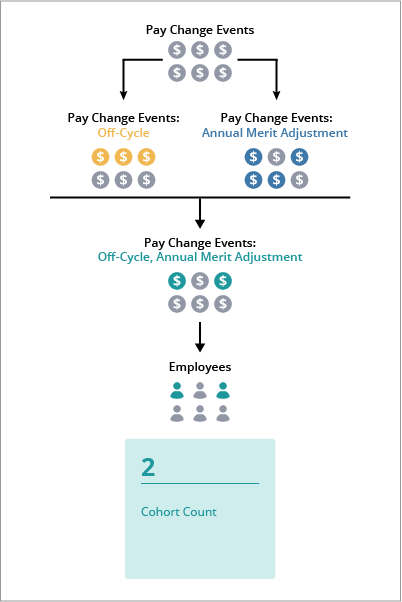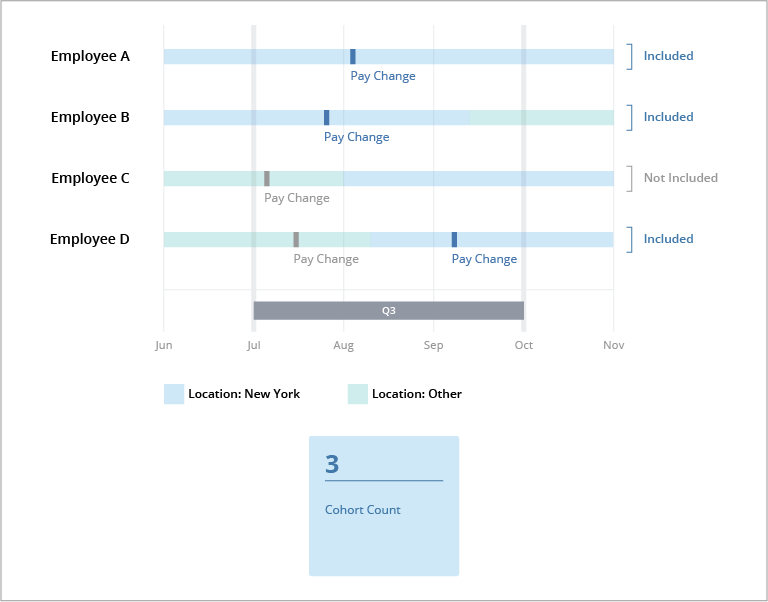How Cohorts are Calculated
Learn how the cohort time context and filters are applied to calculate cohort populations.
How the cohort time context is applied
The cohort time context is important in determining how a cohort population is calculated. The solution applies the cohort time context differently based on the type of filters used in the cohort definition.
When the cohort definition contains only filters based on attributes, the cohort time context is interpreted as a point-in-time, specifically the last instant of the cohort time context.
Example:
Let's say your cohort is defined as Employee > Contract Type: Contingent; Employee Job Name: Graphic Designer @ Q1 2019. In this example, the time context is interpreted as a point-in-time, so any employee who is a contingent, graphic designer as of March 31, 2019 is included in the cohort population.
When the cohort definition contains at least one filter that is based on an event occurrence or a change in a subject member's attribute, the cohort time context is interpreted as an interval that spans the entire specified time context.
Example:
Let's say your cohort is defined as Employee > Any change > Job Name @ Q1 2019. In this example, the time context is interpreted as an interval, so any employee whose job name changes at any point between January, 1 2020 and March 31, 2020 is included in the cohort population.
How cohort filters are applied
You can add filters to define your cohort population based on:
- Subject member attributes (for example, Employee attributes such as Location and Tenure)
- Event occurrences (for example, Promotions and Pay Changes)
- Changes to attribute values (for example, change in Location from New York to Vancouver)
To ensure that the cohort populations match their intended use, filters are applied based on the following rules:
When the cohort definition contains multiple filters for the same event occurrence, the filters are applied to the full set of event occurrences instead of the subject member population.
Example:
Let's say your cohort definition contains the following filters:
- Employee > Pay Change Event > Pay Change Cycle: Off-Cycle
- Employee > Pay Change Event > Pay Change Reason: Annual Merit Adjustment
To calculate the cohort population, we consider all Pay Change Events that occur during the cohort time context and then apply the filters so that we're left with Pay Change Events that meet both the filter criteria. As a result, we get a cohort population that consists of employees who had an Off-Cycle, Annual Merit Adjustment Pay Event.

Without this rule, the filters would be applied to the subject member population. This means an employee who had an Off-Cycle, Move-Related Adjustment Pay Change Event and an On-Cycle, Annual Merit Adjustment Pay Change Event during the period would be included in your cohort.
When the cohort definition contains a filter that is based on an event occurrence or a change in a subject member's attribute, all non-event filters are applied at the point-in-time when the event or change occurs.
Example:
Let's say your cohort definition contains the following filters:
- Employee > Has Any Pay Change Event
- Employee > Location: New York
To calculate the cohort population, we consider all Pay Change Events that occur during the cohort time context. The Location filter is applied to the employee at the time when the Pay Change Event occurs. As a result, we get a cohort population that consists of employees who had a Pay Change Event when they were located in New York.
Let's say our cohort time context is set to Q3 2019.
The following illustration shows how a cohort population is formed from a group of employees who experienced Pay Change Events during Q3 2019

- Employee A, B, and D are included in the cohort because their pay changed when they were located in New York.
- Employee C is not included in the cohort because their pay changed when they were in another location.
Without this rule, the non-event filters would be applied at the end of the cohort time context. This means Employee C would have been included in the cohort because their pay changed during the period and they were located in New York at the end of the period.
